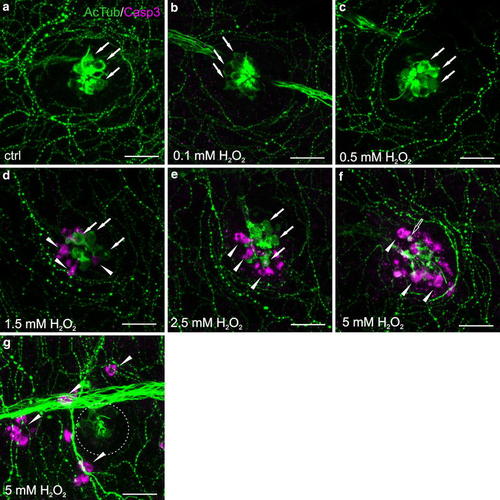- Title
-
Protective Effects of Pituitary Adenylate Cyclase-Activating Polypeptide (PACAP) Against Oxidative Stress in Zebrafish Hair Cells
- Authors
- Kasica, N., Podlasz, P., Sundvik, M., Tamas, A., Reglodi, D., Kaleczyc, J.
- Source
- Full text @ Neurotox Res
|
Morphology of L2 neuromast hair cells in 5 dpf zebrafish (see Fig. 3) exposed for 1 h to H2O2 in dose-dependent manner, double-stained with antibodies against acetylated α-tubulin (AcTub) (green) and caspase-3 (Casp3) (magenta). The visualization was accomplished using a Zeiss LSM-700 confocal microscope. Life hair cells were stained with anti-AcTub antibody (arrows) and the apoptotic hair cells were marked with anti-Casp3 antibody (arrow heads). a Hair cells in the control group characterized by proper morphology without any apoptosis. b, c Low H2O2 doses resulted in unchanged hair cells morphology after both 0.1 mM (b) and 0.5 mM (c) H2O2 exposure. d 1.5 mM is the minimum H2O2 concentration resulted in strong and evident apoptosis recognized based on Casp3 detection (arrow heads). Casp3 immunoreactive (IR) hair cells undergoing apoptosis are irregularly shaped and fragmented, detaching from neuromast rosette. e neuromast rosette is more violated and blebs are observed occasionally. f Hair cells are entirely destroyed and those remaining ones are only Casp3 IR. Some separated, shrunken cells are observed (hollow arrow) pointing to advanced apoptosis events. In some cases, 5 mM H2O2 caused neuromast destruction without Casp3 appearance, suggesting that other death pathways may be involved as well (dotted circle) (g). The only centrally located rosette remaining is neuromast innervation (f, g). In 1.5 mM (d) and 2.5 mM (e), H2O2 concentration apoptosis is restricted to the neuromast hair cells, while 5 mM H2O2 exposure leads to other cell types death, e.g., skin cells (g). N = 15/group. Scale bars 20 µm (Color figure online) |
|
Immunohistochemical staining of the 5 dpf zebrafish neuromasts using antibodies against acetylated ±-tubulin (AcTub) (green) and caspase-3 (Casp3) (magenta). The visualization was accomplished using a Zeiss LSM-700 confocal microscope. The hair cells were stained with AcTub antibody and the apoptotic hair cells were marked with Casp3 antibody. a, b, c five trunk neuromasts (arrows from left to right: L1, LII1, LII2, LII3, L2, respectively) in the control animals (a), in the animals after 1 h 1.5 mM H2O2 exposure (b) and in the animals after 1 h 1.5 mM H2O2 + 100 nM PACAP-38 exposure preceded by 1 h preincubation with 100 nM PACAP-38 only (c) presented in a merged form with marked AcTub and Casp3 double-staining. a′-c′ Casp3 in hair cells of neuromasts L1, L II1, LII2, LII3, L2 (arrows) in the control animals (a′), in 1 h 1.5 mM H2O2-exposed group (b′) and in 1 h 1.5 mM H2O2 + 100 nM PACAP exposure + 1 h 100 nM PACAP preincubation group (c′) visualized without AcTub. a”–c′′ the presence of the apoptotic hair cells in the trunk neuromast L2 in the control animals (a′′), in the animals after 1 h 1.5 mM H2O2 exposure (b”) and in the animals after 1 h 1.5 mM H2O2 + 100 nM PACAP exposure preceded by 1 h preincubation with 100 nM PACAP only (c′′). The immunohistochemical staining is visualized in a merged form, where the AcTub and Casp3 double staining is distinctly marked. N = 15/group. Scale bars a, a′; b, b′; c, c′ 100 µm; a′′; b′′; c′′ 20 µm (Color figure online) |
|
Immunohistochemical staining of the zebrafish neuromasts using antibodies against acetylated α-tubulin (AcTub; green) and phosphorylated p-38 MAPK (phospho-p-38 MAPK; magenta). The visualization was achieved using a confocal microscope. a-c the trunk neuromast L2 with the hair cells affected with phosphorylated form of p-38 MAPK presented in a merged form with marked AcTub and phospho-p-38 MAPK double-staining. a'-c' the presence of phophorylated form of p-38 MAPK in the hair cells. Single hair cells with activated p-38 were found in the control individuals (a, a'). 1.5 mM H2O2 exposure resulted in an unequivocal increase in the volume (µm3) of phospho-p-38 MAPK in the hair cells (b, b'). 100 nM PACAP-38 1 h preincubation did not change the volume of phospho-p-38 MAPK in the hair cells as compared to that determined in the 1.5 mM H2O2-treated group (c, c'). N = 15/group. Scale bars 10 µm (Color figure online) |



